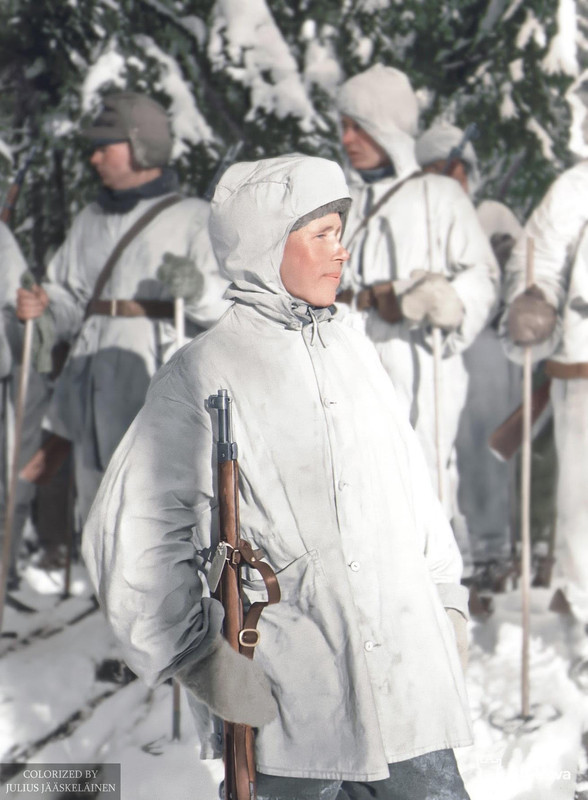
Simo Häyhä at Loimola, Karelia, 1 February 1940.
Simo "Simuna" Häyhä 17 December 1905 – 1 April 2002, was a Finnish sniper. He is believed to have killed over 500 men during the 1939–40 Winter War, the highest number of sniper kills in any major war…
Häyhä was a soldier who filled the boots of a fighter in a tight spot. He was a very efficient soldier and he became sort of an idea or symbol of the fighting spirit of the Winter War already during the war. A symbol of the fight between David and Goliath. A man who fought against the mechanized army with a rifle. A man who was made a legend, though as the humble man he was, he probably did not wish such a fate for himself. But it happened and the legend is more alive today than it ever was. And this legend of course includes the number of Soviet soldiers who met their fate through Häyhä´s m/28-30 rifle.
In public, in literature and especially in various Internet forums numbers are thrown as truth without any knowledge on the matter. This of course is naturally part of being a legend. These numbers 542, 542 + 200, 700 etc. are without any base or reality in them. The numbers have been invented when time has gone by and now the numbers live their own life as part of the legend of Häyhä, The White Death. There is also no single source that would support the claims that the Soviet soldiers named him as the White Death or that they even knew he existed. These are all modern stories invented long after the war and have circulated on and off the Internet.
But. There is info available – Finnish archives and literature sources in this case that has been studied by Finnish historians, as well as Soviet archives studied by Russian military historian Oleg Kiselev. Of Course considering the nature of the case, there never will be absolute truth about the numbers. It is impossible. But according to sources it can be presented as follows:
22.12.1939 = 138 [1]
+61
26.01.1940 = 199 [2]
+20
16.02.1940 = 219 [3]
+40
07.03.1940 = 259 [1]
[1] Rantamaa, A. J. 1942. Parlamentin palkeilta Kollaanjoen kaltahille. WSOY, Porvoo. Pages 84, 206. (Memoirs of the reverend Rantamaa, who served at Kollaa Front)
[2] Perus 2962. Finnish National Archives, War History Department; War Diary of the unit Häyhä served. "[...] Hän on ampunut suomalaisella pystykorvakiväärillä 199 ryssää, jos tilanne on ollut kireämpi tai komppaniamme ollut hyökkäämässä, niin silloin S. Häyhä on toiminut pk. tai kp. ampujana, joten hänen konetuliaseilla ampumansa ryssämäärä kohonnee vähintään yhtäsuureksi kuin kiväärilläkin ammuttujen luku. [...]" (He has shot 199 Russians with rifle. If the situation has been more dire he has acted as a SMG or LMG gunner, thus the amount of enemies shot goes probably as high with automatics.)
[3] Finnish National Archives, War History Department; War Diary of the unit Häyhä served. "[...] Hänen tekonsa - 219 vihollista vain kiväärillä ammuttuna ja suunnilleen saman verran konepistoolilla - [...]" (His deeds are 219 enemies shot with a rifle and approximately the same amount with SMG.)
In 2017 there was a book published by Hannu Narsakka about the Kollaa Front. ”Tulimyrsky Kollaalla” (Firestorm over Kollaa, sadly the book is only in Finnish) where he writes about the Battle of Kollaa in detail. He also takes a critical look on Häyhä and his activities at Kollaa. Narsakka came to same sort of conclusion using archive material and memoirs i.e.. that the number of enemies killed with a rifle could be at the most around ~250. In his own memoir diary written after the war Häyhä writes that his ”list of sin” is around 500. But it was written in summer of 1940 and it already connects to the image of Häyhä and the heroic Battle of Kollaa River created by the media at that time. Maybe Häyhä just accepted the veil that the media had weaved on him. Because not even he could know for sure how many enemies he had killed with his rifle. And he most certainly could not know how many flames he had put out with an SMG. In the midst of a hellish firefight nobody counts and can not count individual kills.
None of this takes the credit or the glory away from Häyhä. There is no doubt that Häyhä was an exceptional soldier and a very effective and skillful sniper. But like in all legends, the real person and the human being behind the legend is often buried and hidden. People in general are not interested in facts but in a good story. It’s like that in most cases and it is the same with most of the snipers of the Second World War. Who really knows the truth about Palvlichenko, Sidorenko, Surkov, Hetzenauer or Zaitsev?
